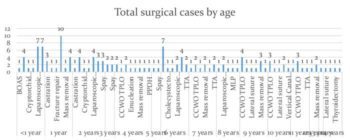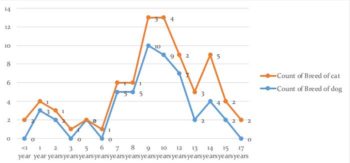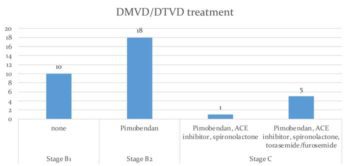11 Oct 2022
Kathryn Ling BVSc, CertVC, GPCert(SAS), MRCVS recalls a year with the Advanced Clinical Services Network around Hampshire.

In October 2019, the Advanced Clinical Services Network (ACSN) was launched with the aim of supporting CVS small animal general practices by having a team of advanced practitioners in fields of medicine, surgery, cardiology and diagnostic imaging available to treat their patients at their home clinic.
As the SARS-COVID19 pandemic abruptly curtailed our prime objective, the team resorted to assisting local practices as best it could, before restarting the peripatetic mission later in 2020. In 2021, the gradual and fluctuating increase in our freedom of movement enabled the development of our peripatetic services.
As we are all aware, 2021 was a challenging time for all veterinary staff. Every practice was suffering staff shortages – veterinary surgeons, veterinary nurses, animal care assistants and support staff – at the same time as the number of patients rose faster than we had ever experienced before.
 As an advanced practitioner in cardiology and small animal surgery, with 25 years of experience in general small animal practice before joining ACSN, the author has a range of skills with which to assist the practices she attends. Across 2021, she recorded the surgeries she performed, the patient details and outcomes, echocardiographic diagnoses and treatments, along with the number of abdominal ultrasound scans and other investigations. The purpose of this paper is to summarise the caseload of one peripatetic advanced practitioner as we navigate our way out of uncertain times.
As an advanced practitioner in cardiology and small animal surgery, with 25 years of experience in general small animal practice before joining ACSN, the author has a range of skills with which to assist the practices she attends. Across 2021, she recorded the surgeries she performed, the patient details and outcomes, echocardiographic diagnoses and treatments, along with the number of abdominal ultrasound scans and other investigations. The purpose of this paper is to summarise the caseload of one peripatetic advanced practitioner as we navigate our way out of uncertain times.
The practices that just had cardiac cases did not feel comfortable with having advanced surgical procedures performed on site, but two of these have already been in discussion about adding these procedures as suitable cases arise.
The practices that only had surgical caseloads, and several that have predominantly surgical caseloads, already had a staff member interested in cardiology or a separate arrangement with another peripatetic cardiologist.
Total surgical cases for the year consisted of 119 dogs, 19 cats and 1 rabbit.
Of the 119 dogs, the majority (43) were cross-breeds with the Labrador retriever being the second-most common. Most patients were less than three years old, a number significantly affected by the number of neuterings performed in the preceding few months.
Surgeries: 139
Cardiology consults (new cases): 76
Abdominal ultrasound: 37
Echocardiography: 80
Medicine investigations: 5
A total of 85 soft tissue procedures and 54 orthopaedic were seen. Of the orthopaedic procedures, 40 were for cranial cruciate ligament ruptures (25 cranial closing wedge osteotomies [CCWO], 5 fusion tibial tuberosity advancements and 10 lateral tibiofabellar sutures).
In October, the author was asked to assist a couple of practices that were extremely short staffed with their routine surgical cases and the odd dental. It may not be in the plan of what ACSN stands for, but the author made a personal choice to help where she could. Often, these days would include an advanced procedure, as well as the routine surgeries, medical advice and general staff support, being it a little teaching or providing a listening ear.
The postoperative outcomes were reviewed. Unfortunately, 15% of the orthopaedic patients did not return after their initial postoperative re-examinations. The remainder of the orthopaedic patients were assessed at around eight weeks post-surgery. Seventy-five per cent had made a full recovery with no complications.
Of the remaining five out of 54 patients, one required additional physiotherapy, two had antibiotics for superficial wound infections and two required surgical intervention. The first surgical intervention was an amputation for a non-union fracture and the owner had run out of funds to pursue further treatment. The second was to remove a loose wire in a CCWO.
Of the soft tissue surgeries, 3 out of 85 – all neuterings – did not return for any of their postoperative assessments. Eighty-seven per cent made full recoveries with no concerns. One from the 85 licked their wound, but did not require any treatment.
 Two vertebral canal ablations and a laparoscopic ovarectomy required additional antibiotics. A bitch spay developed acute renal disease two weeks after surgery, but no cause was identified. A liver biopsy required additional analgesia and hospitalisation after the nurses disposed of the original surgical biopsy, and the surgery had to be repeated. Two cases, a cholecystectomy and a pylorectomy, required additional medication two to three weeks after their surgeries for vomiting that resolved in a couple of days.
Two vertebral canal ablations and a laparoscopic ovarectomy required additional antibiotics. A bitch spay developed acute renal disease two weeks after surgery, but no cause was identified. A liver biopsy required additional analgesia and hospitalisation after the nurses disposed of the original surgical biopsy, and the surgery had to be repeated. Two cases, a cholecystectomy and a pylorectomy, required additional medication two to three weeks after their surgeries for vomiting that resolved in a couple of days.
There were 76 new cardiology referrals and 80 echocardiography examinations carried out; 29 cats and 51 dogs. Eighty-six per cent of the patients were neutered, and the majority of patients were between 7 and 14 years old.
Of the dogs, 19 different breeds were recorded, including crossbreeds. The more common dog breed examined was the Cavalier King Charles spaniel at 20% and 17.6% were crossbreeds. Thirty four from 80 were diagnosed with degenerative myxomatous mitral and/or tricuspid valve disease (DMVD/DTVD). Nine patients were diagnosed with congenital cardiac conditions.
 Patients were prescribed a wide range of medical treatments. Focusing on the treatment of cases diagnosed with DMVD/DTVD, you can see the application of the American College of Veterinary Internal Medicine guidelines from 2019. Cases diagnosed as in stage B1 (29%) did not receive treatment as they did not demonstrate any cardiac remodelling.
Patients were prescribed a wide range of medical treatments. Focusing on the treatment of cases diagnosed with DMVD/DTVD, you can see the application of the American College of Veterinary Internal Medicine guidelines from 2019. Cases diagnosed as in stage B1 (29%) did not receive treatment as they did not demonstrate any cardiac remodelling.
Patients diagnosed with stage B2 – cardiac remodelling without congestive heart failure, 53% – only received pimobendan. Patients diagnosed with stage C or D – congestive heart failure, 18% – received a range of medication based on their specific findings.
Despite the limitations placed across society in 2021, this data provides a demonstration of the range of advanced practitioner services supplied to GP practices within the CVS Group.
These services have provided timely, quality care for patients within their home practice, which has benefited the clients in reducing their need to travel to specialist centres, and the staff of these practices by providing interesting and unusual procedures, and in-house training.